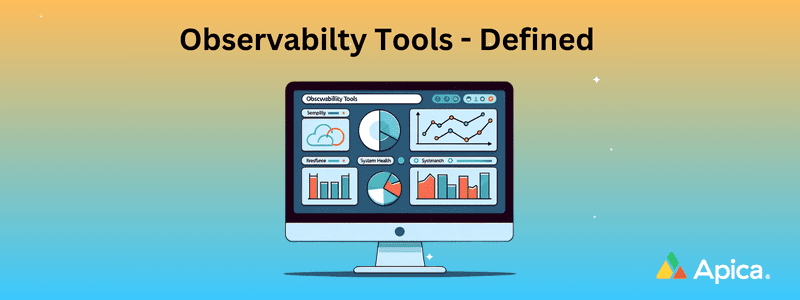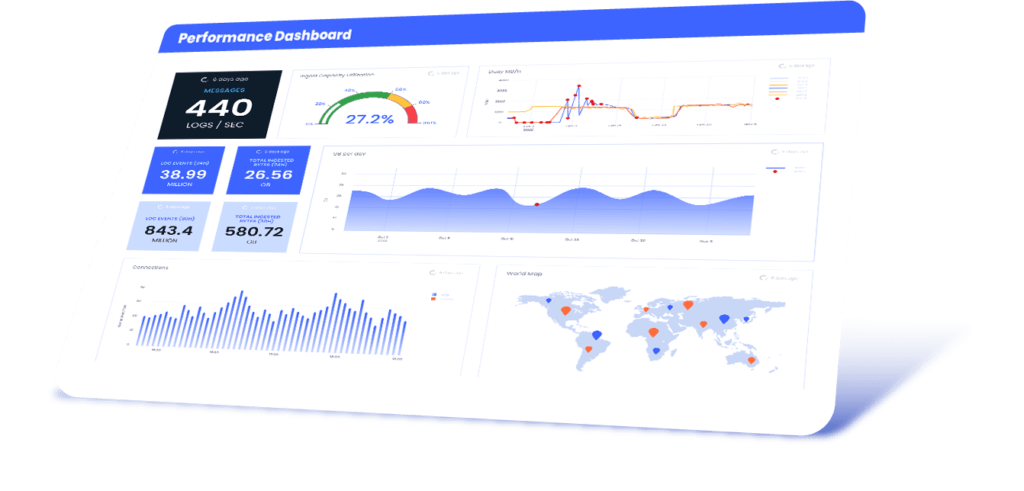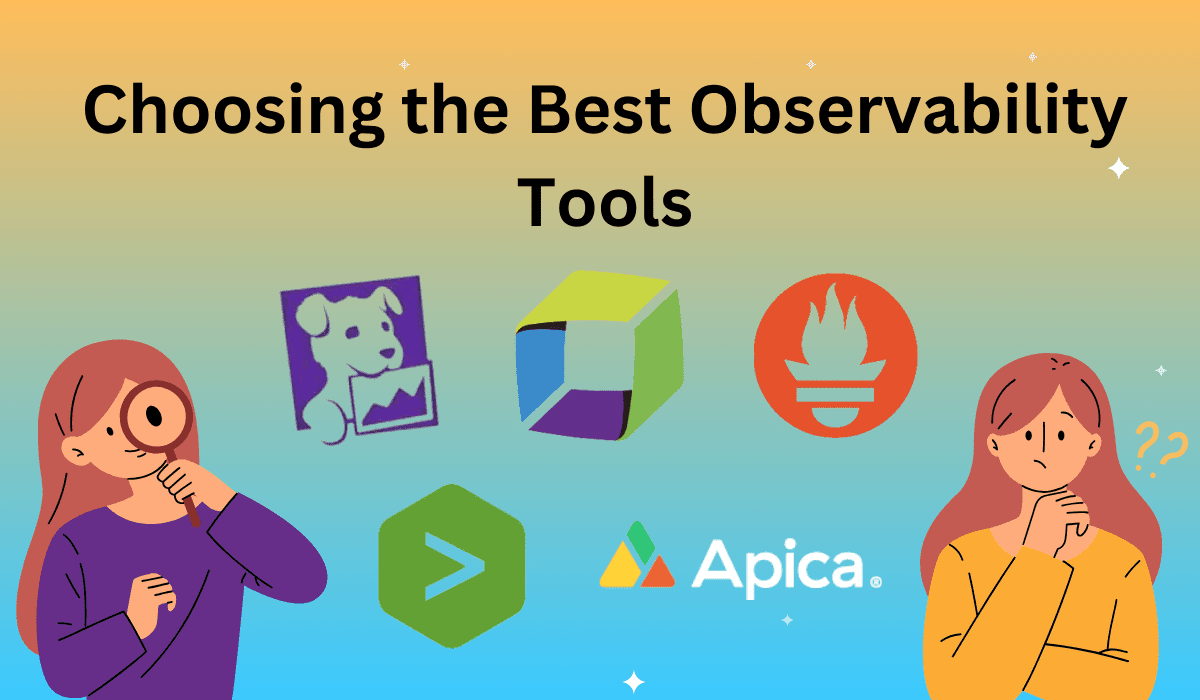With a slew of options at hand, choosing the best observability tools is challenging. Not to mention the strenuous task of researching the web, reading reviews, and scheduling demos to find the best option.
That said, I believe the better question should be “How to choose the right observability tools for you?” This article aims to answer that along with a detailed overview of what features to look for, what are the challenges, and how to choose a compatible observability tool for your enterprise.
What are Observability tools?

Observability tools serve as centralized platforms that not just monitor but analyze your system’s key data aspects including logs, metrics, traces, events, etc. Simply put, they offer an all-encompassing monitoring solution by collecting data from various sources.
The Observability tools are particularly adept at dealing with “unknown unknowns” – issues or problems within a system that are not anticipated or predictable based on existing knowledge or data. Unlike standard monitoring solutions that alert you to known issues, observability tools dive deeper.
Benefits of Observability Tools
There are numerous benefits of Observability tools. Be it for root cause analysis, alert generation or error detection, the insights they generate are invaluable, especially in environments with microservices architectures or distributed systems, where pinpointing problems can be extremely challenging.
Observability tools uncover both known and developing problems, in that they reveal complex dependencies within your system. They are more than just reactive; they’re proactive, providing predictive analytics to identify potential issues before they escalate. By combining metrics and logs, observability tools grant a holistic perspective on your network’s health and performance. They are particularly effective in quickly evolving business landscapes, enabling teams to proactively tackle potential concerns and boost overall system performance.
“Every organization has a digital presence now. Observability is not a cutting-edge differentiator—it’s a core competency. And it’s a basic ingredient that every company needs to look at for their success.”
Mala Pillutla (Forbes Virtual Event)
Key Features to Look for in Observability Tools
When selecting an observability tool, there are several key features to consider that play crucial deciding factors, some of which include:
- Anomaly Detection: For scaling systems, anomaly detection is essential. Look for tools with AI/ML capabilities that can automatically detect anomalies. These should be based on algorithms trained on extensive datasets to identify a range of unusual behaviors, aiding in quick troubleshooting and cost reduction.
- Alerting: A robust alerting system is foundational. It should scan telemetry data continuously, notifying you of critical events based on specified conditions and thresholds. Alerts should be customizable to your business needs and deliverable through multiple channels to ensure swift action.
- Distributed Tracing: Essential for applications built with microservices architecture, distributed tracing helps in identifying the root causes of failures and performance issues. Your tool should facilitate distributed tracing to provide a comprehensive view of request execution and latency sources.
- Cost Control: Observability costs can escalate quickly. Tools should offer automated data optimization, allowing you to control data volumes and related costs effectively. This ensures you only pay for data essential to your observability needs, avoiding unnecessary expenses on irrelevant data.
- Customizable Dashboards: Given the vast volumes of telemetry data, tools with pre-built dashboards can save considerable time. These dashboards should be customizable, providing immediate insights without the need for extensive configuration.
- Service Instrumentation: Look for tools that provide automated service instrumentation, which can streamline the process of exposing logs, metrics, and traces. Features like service discovery and easy data collection are vital for quick and efficient observability setup.
- Data Correlation: The tool should offer seamless data correlation, enabling quick and efficient troubleshooting. This is particularly important in environments with microservices, where correlating data from various components is key to isolating issues.
Common Challenges for Observability Tools
Choosing an observability tool can be a complex task, fraught with several challenges that organizations need to navigate.
Some of the common challenges include:
- Integration with Existing Systems: Ensuring the new observability tool seamlessly integrates with the existing technology stack and infrastructure is a significant challenge. Incompatibilities lead to additional costs and complexities.
- Data Overload: Observability tools generate a vast amount of data. Sifting through this data to find relevant insights without getting overwhelmed or missing critical information is difficult.
- Cost Management: The cost of observability tools can vary greatly, and there is often a fine line between the features offered and the price. Balancing budget constraints with the need for a robust solution is a common challenge.
- Complexity in Use and Maintenance: Some observability tools can be complex to set up, use, and maintain. This complexity requires skilled personnel and can result in increased training and operational costs.
- Scalability: As the organization grows, the observability tool must scale accordingly. Finding a tool that can handle increased load without performance degradation is crucial.
- Real-Time Analysis and Alerting: The ability to analyze data in real-time and send timely alerts is critical. Some tools may not provide sufficiently fast analysis or customizable alerting, impacting the ability to respond to issues promptly.
- Customization and Flexibility: Different organizations have unique needs. A tool that offers customization and flexibility to adapt to specific requirements is essential but can be hard to find.
- Security and Compliance: Ensuring the observability tool complies with industry standards and security regulations is a major concern, especially for organizations in highly regulated sectors.
- Support and Vendor Reliability: Dependable vendor support is crucial for troubleshooting and resolving issues. Evaluating the reliability and responsiveness of the tool provider is necessary.
- Determining the Right Features: With a plethora of features available, determining which are necessary for the organization’s specific context requires time and research.
Choosing the Best Observability Tools
The right observability tool should offer a blend of proactive alerting, intelligent anomaly detection, cost-effective data management, easy-to-use dashboards, efficient data correlation, automated service instrumentation, and comprehensive distributed tracing capabilities.
Moreover, navigating the challenges associated with choosing the right observability is imperative. Careful consideration, research, and often a degree of trial and error are required to find the observability tool that best fits your organization’s unique needs and constraints.
Explore Apica’s Observability Solutions

Apica’s ascent platform is crafted to integrate smoothly with your existing tech infrastructure, offering in-depth insights into system performance and health.
Moreover, our focus on user-friendly interfaces and robust analytics ensures efficient handling of large data volumes.
Furthermore, Apica is the first data fabric to integrate Generative AI into its platform. Our Active Observability approach provides a comprehensive understanding and proactive management of your digital environment.
Conclusion
In the era of DevOps and continuous integration/continuous deployment (CI/CD), observability tools are imperative. They should integrate seamlessly into the development lifecycle, facilitating faster and more efficient releases without sacrificing quality.
Keep in mind that observability tools go beyond simple network monitoring; they offer a comprehensive view of the vitality and efficiency of your digital landscape. Whether you’re just starting or advancing your journey in observability, it’s imperative to precisely identify how these tools will integrate into your infrastructure and the specific insights you intend to extract from them.
TL; DR
- Selecting observability tools involves evaluating enterprise compatibility, researching, and considering specific needs.
- Observability tools analyze system data like logs and metrics, addressing both predictable and unforeseen issues.
- Benefits include enhanced error detection, predictive analytics, and effective problem-solving in complex systems.
- Essential features: anomaly detection, alerting, distributed tracing, cost management, customizable dashboards, service instrumentation, and data correlation.
- Challenges: integrating with current systems, managing data and costs, tool complexity, scalability, real-time capabilities, customization, security, vendor support, and feature selection.
- Ideal tools combine proactive alerting, efficient data management, user-friendly interfaces, and comprehensive tracing.
- Apica’s solutions emphasize seamless integration, ease of use, robust analytics, and Generative AI.
- Observability tools are crucial in DevOps for efficient, quality software releases, offering a holistic view of digital infrastructures











